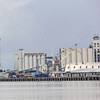IMO Secretary-General Expresses Sadness at Tanzania Ferry Disaster
The Secretary-General of the International Maritime Organization (IMO), Efthimios E. Mitropoulos, has expressed his profound sadness for the loss of life in the sinking of the ro-ro ferry Spice Islander I off the coast of the United Republic of Tanzania on 10 September.
“We are shocked at the number of lives lost and have offered any help and technical assistance which may be required,” Mr. Mitropoulos said, adding that IMO was willing to provide assistance in investigating the cause of the accident and, following on from that, in working with the United Republic of Tanzania to prevent further such accidents occurring.
Mr. Mitropoulos commended the work of the Dar es Salaam Maritime Rescue Coordination Centre (MRCC) sub-centre (which was commissioned by IMO in 2009) in coordinating the rescue. The sub-centre confirmed to IMO on Monday (12 September) that, so far, 187 bodies had been recovered and 619 people had been rescued.
While IMO regulations, such as those contained in the International Convention for the Safety of Life at Sea (SOLAS), do not apply to ships trading on domestic routes, IMO has worked with a number of countries and non-governmental organizations to improve safety on so-called “non-convention” vessels.
With the assistance of IMO, model safety regulations for inland waterways vessels and non-convention craft, including fishing vessels operating in Africa, were developed in 2001. Those regulations were agreed by representatives of Burundi, Ghana, Kenya, Malawi, Mozambique, Nigeria, Rwanda, Sierra Leone, Uganda, United Republic of Tanzania, Zambia and Zimbabwe. The model regulations were aimed at providing a regional safety and pollution prevention standard for new vessels and barges and, as appropriate, existing vessels and convention-sized ships that trade regularly on inland waterways and at sea on non-international voyages, and for personnel serving aboard them.
Search and rescue coverage around Africa
Search and rescue coverage around Africa has been developed following the 2000 IMO Conference on Search and Rescue and the Global Maritime Distress and Safety System (GMDSS), held in Florence, Italy. In one of the resolutions adopted by the Conference, African countries bordering the Atlantic and Indian Oceans (from Morocco to Somalia, anti-clockwise, as well as the nearby Atlantic and Indian Ocean Island States) were invited to establish, in co-operation with IMO, five sub-regional centres and 26 sub-centres to cover their entire coastline areas for search and rescue coordination purposes, in order to provide search and rescue coverage in what had previously been identified as one of the areas suffering most from a lack of adequate SAR and Global Maritime Distress and Safety System infrastructure.
This process was finalized earlier in 2011 with the signing of an agreement on the North and West African sub-regional Maritime Rescue Coordination Centre (MRCC), establishing a new MRCC near Rabat, Morocco. This had been preceded by MRCCs commissioned in Mombasa, Kenya, in 2006 (its sub-centres in Dar es Salaam and Victoria, Seychelles, were both commissioned in 2009); in Cape Town, South Africa, in 2007; in Lagos, Nigeria, in 2008; and in Monrovia, Liberia, in 2009, completing the chain of sub-regional African MRCCs, each with its own network of associated sub-centres.













